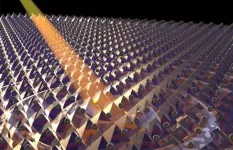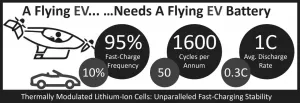(Press-News.org) UPTON, NY--What happens when very short pulses of laser light strike a magnetic material? A large international collaboration led by the U.S. Department of Energy's (DOE) Brookhaven National Laboratory set out to answer this very question. As they just reported in the Proceedings of the National Academy of Sciences, the laser suppressed magnetic order across the entire material for several picoseconds, or trillionths of a second. Understanding how magnetic correlations change on ultrafast timescales is the first step in being able to control magnetism in application-oriented ways. For example, with such control, we may be able to more quickly write data to memory devices or enhance superconductivity (the phenomenon in which a material conducts electricity without energy loss), which often competes with other states like magnetism.
The material studied was strontium iridium oxide (Sr3Ir2O7), an antiferromagnet with a bilayer crystal structure and a large magnetic anisotropy. In an antiferromagnet, the magnetic moments, or electron spins, align in opposite directions to neighboring spins. Anisotropy means the spins need to pay an energetic cost to rotate in any random direction; they really want to sit pointing upwards or downwards in the crystal structure. The X-ray Scattering Group of Brookhaven Lab's Condensed Matter Physics and Materials Science (CMPMS) Division has previously studied this material (and a single-layer sister compound, Sr2IrO4), so they entered this study with a good understanding of its equilibrium state.
"The very short laser pulses disturb the system, destroying its magnetic order," said first author Daniel Mazzone, former group member and now an instrument scientist at the Continuous Angle Multiple Energy Analysis (CAMEA) spectrometer at the Paul Scherrer Institute in Switzerland. "In this study, we were interested in seeing how the system relaxes back to its normal state. We knew the relaxation occurs on a very fast timescale, and to take a picture of something that moves very fast, we need very short pulses of illumination. With an x-ray free-electron laser source, we can generate pulses short enough to see the movement of atoms and molecules. Such sources only exist at five places around the world--in the United States, Japan, Korea, Germany, and Switzerland."
In this study, the team ran experiments at two of the five facilities. At the SPring-8 Angstrom Compact free-electron Laser (SACLA) in Japan, they conducted time-resolved resonant elastic x-ray scattering (tr-REXS). At the x-ray pump-probe instrument of the Linac Coherent Light Source--a DOE Office of Science User Facility at SLAC National Accelerator Laboratory--the scientists performed time-resolved resonant inelastic x-ray scattering (tr-RIXS). In both scattering techniques, x-rays (probe) strike the material almost immediately after the laser pulse (pump). By measuring the energy and angle of scattered particles of light (photons), scientists can determine the material's electronic structure and thus magnetic configuration. In this case, the x-ray energy was tuned to be sensitive to the electrons around iridium atoms, which drive magnetism in this material. While tr-REXS can reveal the degree of long-range magnetic order, tr-RIXS can provide a picture of local magnetic interactions.
"In order to observe the detailed behavior of spins, we need to measure the energy change of the x-rays with very high precision," explained co-corresponding author Mark Dean, a physicist in the CMPMS Division X-ray Scattering Group. "To do so, we built and installed a motorized x-ray spectrometer at SLAC."
Their data revealed how magnetic interactions are suppressed not just locally but everywhere. This suppression persists for picoseconds before the magnetic order returns to its initial antiferromagnetic state.
"The bilayer system does not have energetically low-cost ways to deform the magnetic state," explained Dean. "It gets stuck in this bottleneck where the magnetism is out of equilibrium and is not recovering, at least not as quickly as in the monolayer system."
"For most applications, such as data storage, you want fast magnetic switching," added Mazzone. "Our research suggests systems where spins can point whichever direction are better for manipulating magnetism."
Next, the team plans to look at related materials and hopes to manipulate magnetism in more targeted ways--for example, changing how strongly two neighboring spins "talk to" each other.
"If we can change the distance between two spins and see how that affects their interaction, that would be really cool," said Mazzone. "With an understanding of how magnetism evolves, we could tweak it, maybe generating new states."
INFORMATION:
The complexity of setting up and operating the spectrometer required a large collaboration including former and current Brookhaven X-ray Scattering Group members Daniel Mazzone, Derek Meyers, Yue Cao, Jiaqi Lin, Vivek Thampy, Hu Miao, Tadesse Assefa, John Hill, Ian Robinson, and Xuerong Liu. James Vale, Cameron Dashwood, and Desmond McMorrow of University College London; Diego Casa and Jungho Kim of DOE's Argonne National Laboratory; laser experts Alan Johnson and Roman Mankowsky of the Paul Scherrer Institut, Michael Först of the Max Planck Institute for the Structure and Dynamics of Matter, and Simon Wall of Aarhus University; and the beamline teams from SLAC and SACLA were also crucial to the success of the experiments. Theoretical collaborations included Robert Konik of Brookhaven and Neil Robinson and Andrew James, both formerly at Brookhaven.
The other collaborating institutions are Oklahoma State University, Chinese Academy of Sciences, The Open University, University of Amsterdam, ShanghaiTech University, RIKEN, Barcelona Institute of Science and Technology, and University of Tennessee.
This research is supported by the DOE Office of Science, Swiss National Science Foundation, the Engineering and Physical Sciences Research Council of UK Research and Innovation, ShanghaiTech University startup fund MOST of China, National Natural Science Foundation of China, Chinese Academy of Sciences, Spanish Ministry of Economy and Competitiveness, Fundació Privada Cellex, Fundació Mir-Puig, Generalitat de Catalunya, European Research Council, and National Science Foundation.
Brookhaven National Laboratory is supported by the U.S. Department of Energy's Office of Science. The Office of Science is the single largest supporter of basic research in the physical sciences in the United States and is working to address some of the most pressing challenges of our time. For more information, visit https://energy.gov/science.
Follow @BrookhavenLab on Twitter or find us on Facebook.
The lack of data is a major bottleneck for many kinds of research, and especially for the development of better medical treatments and drugs. This data is extremely sensitive and, understandably, people and companies alike are often unwilling to share their information with others.
Researchers at the Finnish Center for Artificial Intelligence have developed a machine learning-based method that produces synthetic data on the basis of original data sets, making it possible for researchers to share their data with one other. This could solve the ongoing problem of data scarcity in medical research and other fields where information is sensitive.
The generated data preserves privacy, remaining similar enough to the original data to be used for statistical ...
Researchers at Queen Mary University of London have tested an algorithm on 700,000 patient records in east London, to find out if the data routinely collected by GPs can reveal cases of Familial Hypercholesterolemia - a leading cause of heart attack in young people.
Familial Hypercholesterolemia (FH) is a condition passed down through families that causes extremely high levels of cholesterol in the blood. Without treatment, it can lead to a heart attack at a very young age. FH affects 320,000 people in the UK, the vast majority of whom are unaware they have it.
One method of detection is the 'FAMCAT' (Familial Hypercholesterolemia Case Assertation Tool) which analyses data in GP records - including ...
The ability of stem cells to fix impaired functions of host tissues after transplantation has been a lifesaving breakthrough in treating previously incurable conditions. Much like a coin toss, however, the fate of the transplanted stem cells is unpredictable. They may choose self-renewal, grow into a different kind of tissue, or die.
Spermatogonial stem cells follow the same stochastic fate of unpredictability in outcomes. But a group of fertility scientists led by Hiroshima University's Yoshiaki Nakamura discovered a new method that has favorably flipped the odds and successfully reversed male infertility in mice -- showing great promise for future applications in regenerating human sperm after cancer treatment ...
Normally, the ACE2 enzyme helps regulate our blood pressure. The enzyme sits on the surface of cells, including cells in the lungs, but in connection with COVID-19 it has been found that ACE2 also functions as a gateway for the virus.
"Different viruses have different ways of accessing our cells - as the virus must, of course, get into the cell to be able to replicate, and the coronavirus uses ACE2 to gain access. For this reason, we're investigating what the concentration of ACE2 means for the course of the disease, if you get COVID-19," explains MD and PhD Tue Wenzel Kragstrup from the Department of Biomedicine at Aarhus University. The preliminary results have just been published in the scientific journal PLOS ONE.
As mentioned, ACE2 is part of the surface of the cells, but ...
AUSTIN, Texas -- Puerto Rico is not ready for another hurricane season, let alone the effects of climate change, according to a new study that shows the island's outstanding capacity to produce record-breaking floods and trigger a large number of landslides.
The latest research, appearing in the journal END ...
Jet packs, robot maids and flying cars were all promises for the 21st century. We got mechanized, autonomous vacuum cleaners instead. Now a team of Penn State researchers are exploring the requirements for electric vertical takeoff and landing (eVTOL) vehicles and designing and testing potential battery power sources.
"I think flying cars have the potential to eliminate a lot of time and increase productivity and open the sky corridors to transportation," said Chao-Yang Wang, holder of the William E. Diefender Chair of Mechanical Engineering and director of the Electrochemical Engine Center, Penn State. "But electric vertical takeoff and landing vehicles are very challenging technology for the batteries."
The researchers define the technical requirements ...
Bdelloid rotifers are multicellular animals so small you need a microscope to see them. Despite their size, they're known for being tough, capable of surviving through drying, freezing, starvation, and low oxygen. Now, researchers reporting in the journal Current Biology on June 7 have found that not only can they withstand being frozen, but they can also persist for at least 24,000 years in the Siberian permafrost and survive.
"Our report is the hardest proof as of today that multicellular animals could withstand tens of thousands of years in cryptobiosis, the state of almost completely arrested metabolism," says Stas Malavin ...
The aurora borealis, or northern lights, that fill the sky in high-latitude regions have fascinated people for thousands of years. But how they're created, while theorized, had not been conclusively proven.
In a new study, a team of physicists led by University of Iowa reports definitive evidence that the most brilliant auroras are produced by powerful electromagnetic waves during geomagnetic storms. The phenomena, known as Alfven waves, accelerate electrons toward Earth, causing the particles to produce the familiar atmospheric light show.
The study, published online June 7 in the journal Nature Communications, concludes a decades-long quest to demonstrate experimentally the physical mechanisms for the acceleration of electrons by Alfven waves under ...
What The Study Did: In this study, short-term effectiveness of the first dose of the BNT162b2 (BioNTech/Pfizer) vaccine against SARS-CoV-2 infection 13 to 24 days after immunization in a real-world setting was assessed.
Authors: Gabriel Chodick, Ph.D., of the Maccabi Institute for Research & Innovation, Maccabi Healthcare Services, in Tel Aviv, Israel, is the corresponding author.
To access the embargoed study: Visit our For The Media website at this link https://media.jamanetwork.com/
(doi:10.1001/jamanetworkopen.2021.15985)
Editor's Note: Please see the article for additional information, including other authors, author contributions and affiliations, ...
What The Study Did: Among children with a COVID-19 diagnosis, researchers in this study examined what other conditions are common and which are associated with severe COVID-19 illness.
Authors: Lyudmyla Kompaniyets, Ph.D., of the U.S. Centers for Disease Control and Prevention in Atlanta, is the corresponding author.
To access the embargoed study: Visit our For The Media website at this link https://media.jamanetwork.com/
(doi:10.1001/jamanetworkopen.2021.11182)
Editor's Note: Please see the article for additional information, including other authors, author contributions and affiliations, conflict of interest and financial disclosures, ...




